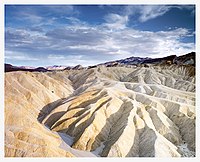
Photo from wikipedia
Giant sand injection complexes (GSIs) are regionally developed in many petroleum systems and have become well known in deep-water clastic settings in the North Sea, California, offshore Angola, and elsewhere… Click to show full abstract
Giant sand injection complexes (GSIs) are regionally developed in many petroleum systems and have become well known in deep-water clastic settings in the North Sea, California, offshore Angola, and elsewhere (Hurst and Cartwright, 2007; Huuse et al., 2010). The GSIs form during shallow burial (generally <1.5 km [0.93 mi]) when pore-fluid pressure rises rapidly to exceed the fracture and lithostatic gradients and regional hydraulic failure occurs in the host strata that causes fluidization and injection of sand into a propagating fracture system (Hurst et al., 2011). Once buried more deeply, these sandstone intrusions are significant reservoir targets that form intrusive traps (Hurst et al., 2006). In deep-water clastic settings, the significance of sand injectites became apparent in the mid to late 1990s during the development of Harding field (Dixon et al., 1995). In 2002, the first deliberate exploration of part of a GSI target led to discovery of the Volund field, Norway (DeBoer et al., 2007; Hurst et al., 2016), which has reserves in excess of 135 million bbl. Despite their growing significance as reservoirs in petroleum systems globally, remarkably little regional-scale mapping of outcrop of GSIs is published. To some extent this reflects a paucity of excellent outcrop, but it also reflects some resistance to the notion that sandstone intrusions can contain commercially significant hydrocarbon volumes, which they clearly do (Hurst et al., 2005). Here and in Vigorito and Hurst (2017) we describe examples of sandstone intrusions from the Panoche Giant Injection Complex (PGIC; Figure 1A, B), the largest known GSI. The PGIC may be unique, because in an area approaching 400 km2 (154 mi2) it has well-exposed relationships between the parent units from which sandstone intrusions emanate, an intrusive complex, and a paleoseafloor onto which sand extruded (Cima Lentil, Figure 1C; …
Journal Title: AAPG Bulletin
Year Published: 2017
Link to full text (if available)
Share on Social Media: Sign Up to like & get
recommendations!